Timeless style

The first in a new concept of limited series 'Icona' cars
The Ferrari Monza SP1, together with the Monza SP2, are the forerunners in a new concept, known as ‘Icona’ (Icon), that taps into a leitmotif of the most evocative cars in the company’s history to create a new segment of special limited series cars for clients and collectors. The intention is to use a modern aesthetic to reinterpret a timeless style, with technologically advanced components and the highest performance possible through continuous innovation.
- CO2 Emissions:
- LOW: 578 g/km
- MID: 354 g/km
- HIGH: 313 g/km
- EXTRA HIGH: 340 g/km
- COMBINED: 366 g/km
- Fuel consumption:
- LOW: 25.5 l/100km
- MID: 15.6 l/100km
- HIGH: 13.8 l/100km
- EXTRA HIGH: 15.0 l/100km
- COMBINED: 16.1 l/100km
NOTE: The values of fuel consumption and CO2 emissions shown were determined according to the European Regulation (EC) 715/2007 in the version applicable at the time of type approval The fuel consumption and CO2 emission figures refer to the WLTP cycle.
In order to be placed on the market, passenger cars carry out a series of tests to verify their compliance with regulations.

The tests to assess fuel consumption, CO2 and pollutant emissions are carried out in the laboratory and are based on specific driving cycles. In this way, the tests are reproducible and the results comparable. This is important because only a laboratory test, which follows a standardized and repeatable procedure, allows consumers to compare different car models.
On 1 September 2017, the new Worldwide harmonised Light-duty vehicle Test Procedure (WLTP) came into force in Europe and will gradually replace the New European Driving Cycle (NEDC) protocol.
NEDC (New European Driving Cycle): it has been the European driving cycle used so far for the measurement of fuel consumption and emissions from passenger cars and light commercial vehicles. The first European driving cycle came into force in 1970 and referred to an urban route. In 1992 it was also considered to have an extra-urban phase and since 1997 it has been used for measuring consumption and CO2 emissions. However, the composition of this cycle is no longer consistent with current driving styles and distances travelled on different types of roads. The average speed of the NEDC is only 34 km/h, accelerations are low and the maximum speed is just 120 km/h.
WLTP procedure: WLTP uses new Worldwide harmonised Light-duty vehicle Test Cycles (WLTC) to measure fuel consumption, CO2 and pollutant emissions from passenger cars and light commercial vehicles. The new protocol aims to provide customers with more realistic data, better reflecting the daily use of the vehicle. The new WLTP procedure is characterized by a more dynamic driving profile with more significant acceleration. The maximum speed increases from 120 to 131.3 km/h, the average speed is 46.5 km/h and the total cycle time is 30 minutes, 10 minutes more than the previous NEDC. The distance travelled doubles from 11 to 23.25 kilometers. The WLTP test consists of four parts depending on the maximum speed: Low (up to 56.5 km/h), Medium (up to 76.6 km/h), High (up to 97.4 km/h), Extra-high (up to 131.3 km/h). These parts of the cycle simulate urban and suburban driving and driving on extra-urban roads and motorways. The procedure also takes into account all vehicle’s optional contents that affect aerodynamics, rolling resistance and vehicle mass, resulting in a CO2 value that reflects the characteristics of the single vehicle.

The WLTP procedure will gradually replace the NEDC procedure. The WLTP applies to new passenger car models from 1 September 2017, to all passenger cars registered from 1 September 2018 and is mandatory for all EU Member States.
Until the end of 2020, both fuel consumption and CO2 emission values in WLTP and NEDC will be present in the vehicle documents. Indeed, NEDC values will be used to assess the average CO2 emissions of cars registered in the EU throughout 2020. In addition, some countries may continue to use the NEDC data for fiscal purposes. From 2021 onwards, WLTP data will be the only consumption/CO2 emissions values for all cars. Used vehicles will not be affected by this step and will maintain their certified NEDC values.
ROAD CONSUMPTION AND EMISSION OF PASSENGER CARS
The new WLTP test procedure is more representative of current driving conditions than the NEDC procedure, but it cannot take into account all possible cases including the effect of the driving style that is specific to each individual driver.
Therefore, there will still be a difference between emissions and consumption measured in the laboratory and those resulting from the use of the vehicle in the real world, and the extent of this difference will depend on factors such as driving behavior, the use of on-board systems (e. g. air conditioning), traffic and weather conditions that are characteristic of each geographical area and each driver.
For this reason, only a standardized laboratory test allows to obtain values with which it is possible to compare vehicles and different models in a fair way.
WHAT CHANGES FOR CUSTOMERS
The new WLTP procedure will provide a more realistic criterion for comparing the fuel consumption and CO2 emission values of different vehicle models as it has been designed to better reflect real driving behavior and take into account the specific technical characteristics of the individual model and version, including optional equipment.

Elegance and refinement, in a pencil stroke
A new tail light concept: the side lights and brake lights have been redesigned as a single unbroken line of light, seamlessly integrated into the slender gap between the two shells. This turns the tail light assembly into a theoretical line that traverses the wings and circles the bonnet, giving the impression that the upper shell is literally suspended above the rest of the volume.

The exterior is completed by wonderfully sculptural 21” five-spoke wheels that were designed specifically to compliment the minimalist lines of the two cars.

Just like on racing cars, extensive use of carbon-fibre has been made throughout the construction of the Monza SP1 to make them light and responsive and to enhance their sporty, aggressive visual appeal.

Racing has always greatly influenced Ferrari design language and the Monza SP1 is linked to the marque’s glorious past by an invisible bond. Its design, in fact, embodies the elegance, performance and innovation that are such an intrinsic part of Ferrari’s past and present.
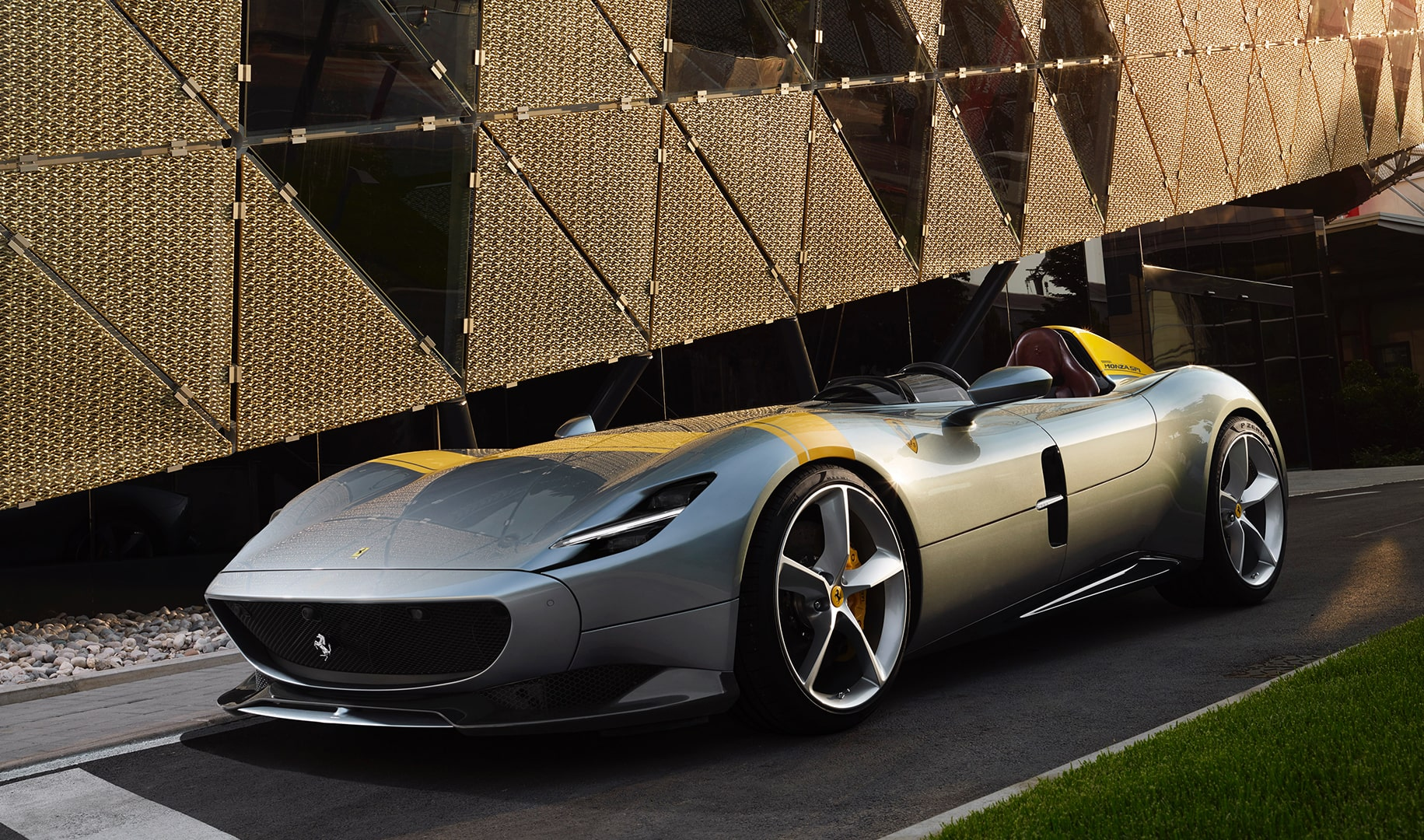
From the point of view of pure creativity, the seductive images of 1950s Ferrari barchettas, that evoke in so many ways the atmosphere of the races of the day, were an invaluable source of inspiration.
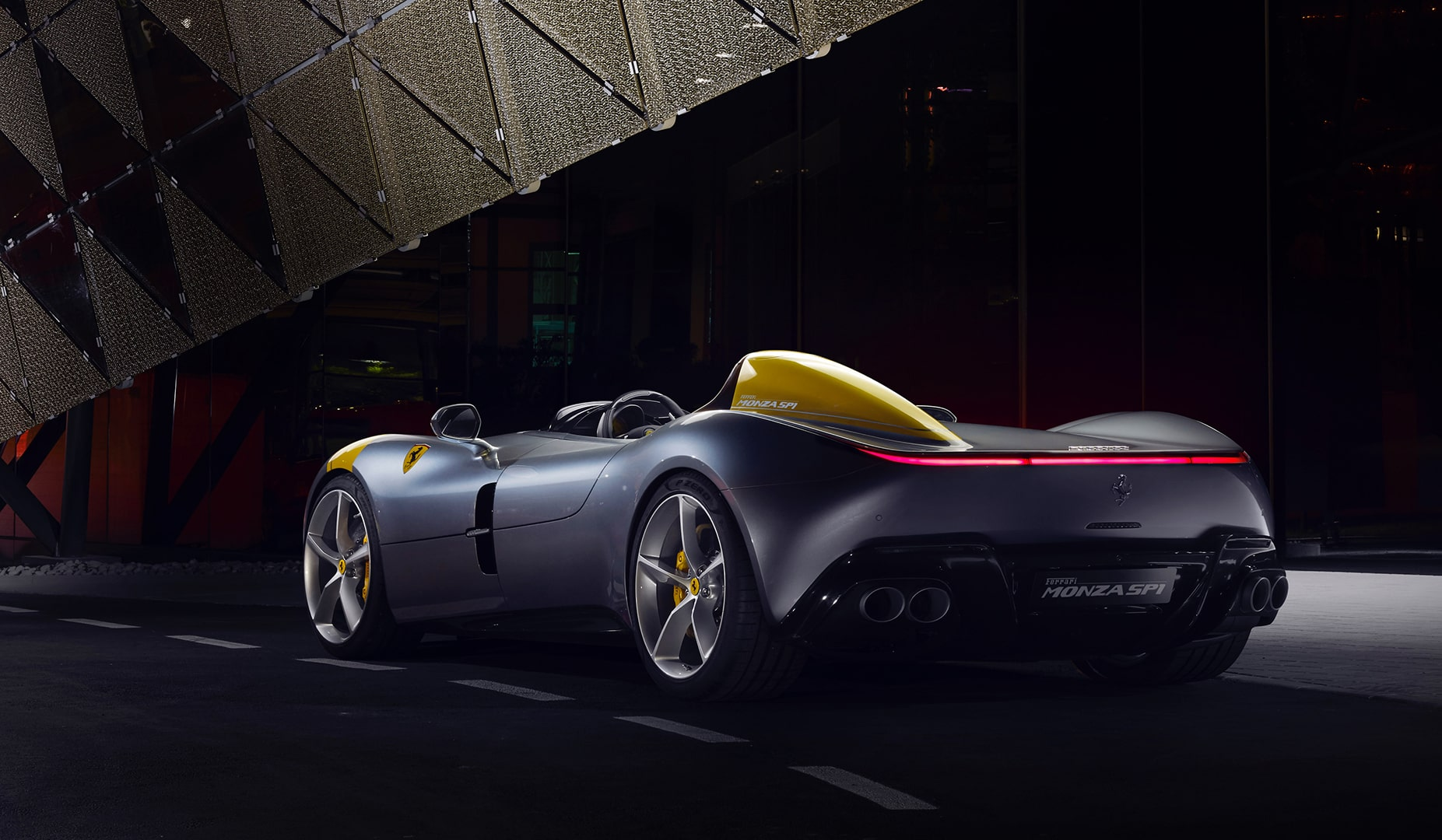
The design language is clearly visible in its elegant forms and the wing-profile volume of the all-carbon-fibre bodyshell, in its proportions, refined details, spare lines.
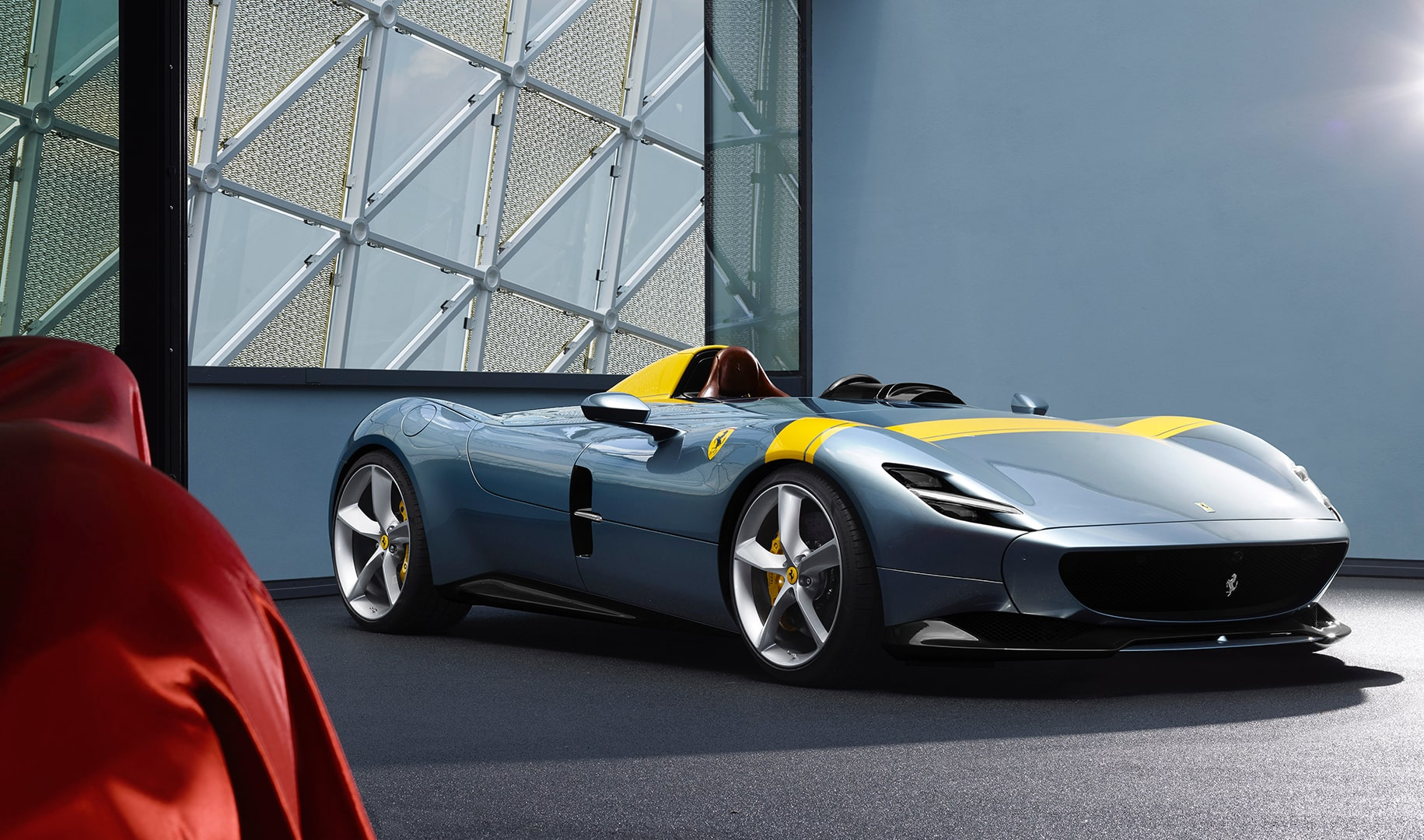
The Monza SP1’s postmodern aesthetic is also clear at the rear which has the soft, sinuous look typical of the Ferraris of the 1950s, a compact tail and full, muscular forms.
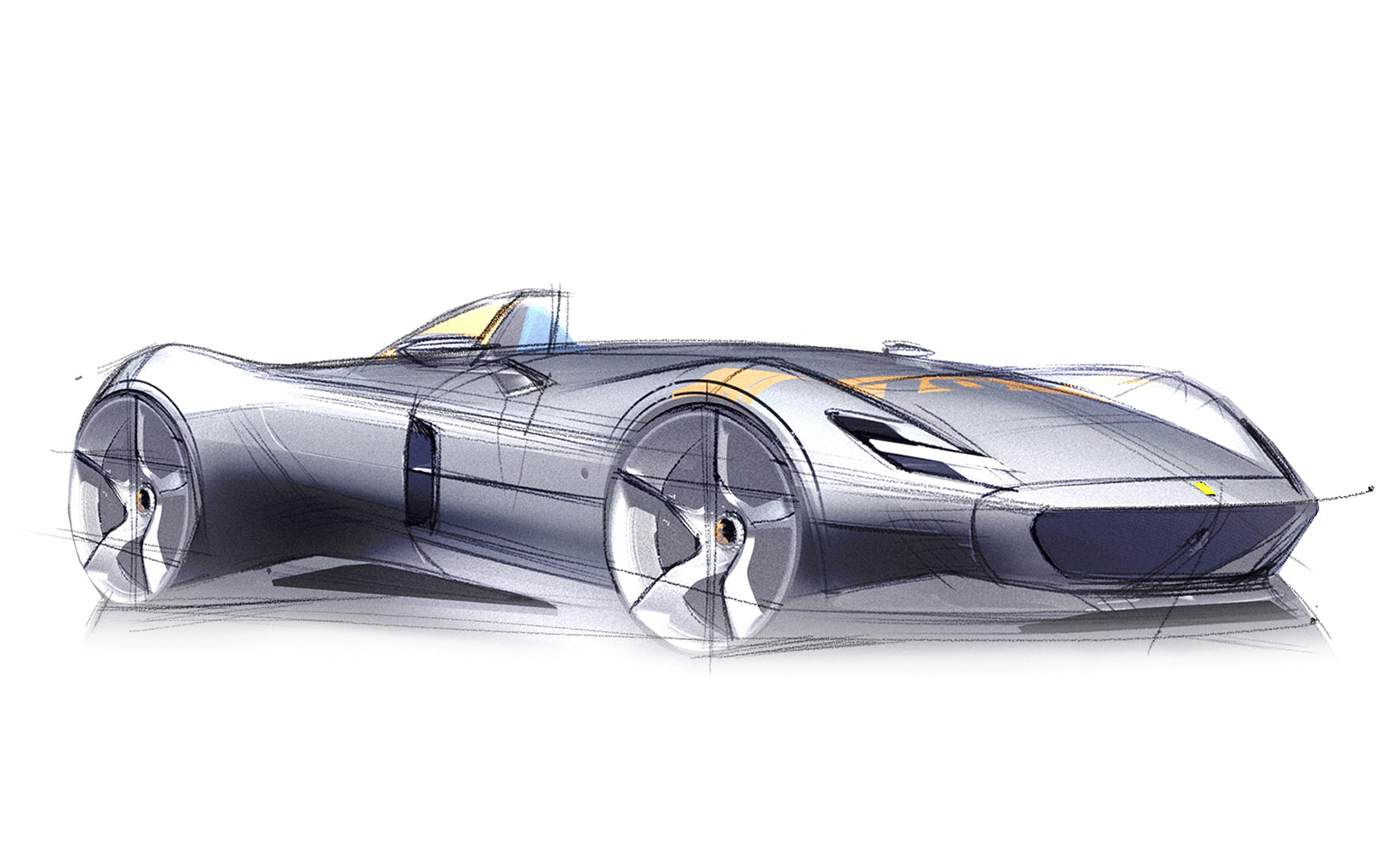

A model whose contours appear crafted by the wind
A car that seems sculpted by the wind. It is the purity of the styling elements that impresses – an aesthetic that is futuristic but, at the same time, a respectful yet un-nostalgic homage to the past.

Racing spirit, absolute comfort
The development of the design of the interior focused specifically on the driver cockpit.
The most powerful V12 ever to leave the gates of Maranello
Amongst these is a 350 bar direct injection system for the very first time on a high-performance petrol engine paired with variable geometry intake tracts conceptually derived from those of naturally-aspirated F1 engines.
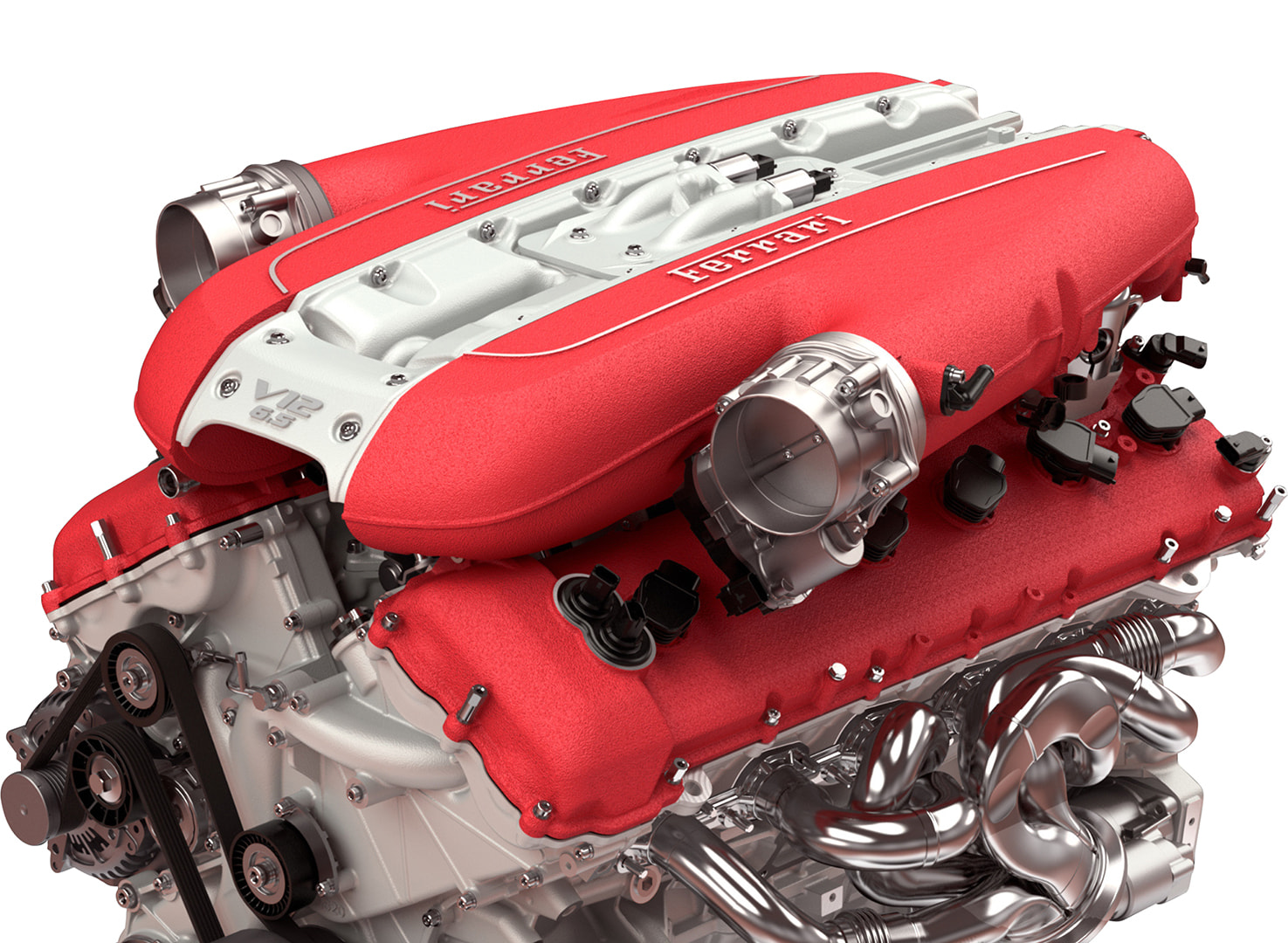
Particular attention was also paid to calibrating the performance strategies to enhance the engine’s potential and the sensation of extreme power delivered by the car while ensuring the driver can easily dose the massive torque available, thanks to smooth, progressive power delivery at all engine speeds.

- V12Engine
- 2,9 sec0-100 KM/H
- 125 cv/lSpecific power output
- 810 cvMax. power output*
The engine in the Monza SP1 is derived directly from that of the 812 Superfast, with optimised fluid-dynamics in the intake ducts to deliver even higher performance.
Formula 1 excitement for an unparalleled driving experience
The Virtual Wind Shield is essentially an aerodynamic passage underneath the driver’s side aero screen, where the upper part is shaped as an aerofoil. Part of the air flowing over the bonnet enters the air intake under the aero screen, where it is accelerated and deflected vertically ahead of the instrument panel. This generates what is known as a highly energised upwash that deflects the flow over the driver’s head creating a low-speed bubble around the cockpit.

The concept was first developed virtually using in-depth CFD modelling and then physically in the wind tunnel. A full-scale mock-up was built specifically for the Wind Tunnel in which our test-drivers alternated with dummies fitted out with pressure sensors (rake and keel probes). With no windscreen whatsoever, the air flowing over the bonnet would hit the driver’s face. The aim with adopting the Virtual Wind Shield was to minimise the negative effect of the air flow without compromising the exhilarating sense of speed and contact with the road that only a car of this kind can deliver.


Maximum comfort with the Virtual Wind Shield
The Virtual Wind Shield is essentially an aerodynamic passage underneath the driver’s side aero screen, where the upper part is shaped as an aerofoil. Part of the air flowing over the bonnet enters the air intake under the aero screen, where it is accelerated and deflected vertically ahead of the instrument panel. This generates what is known as a highly energised upwash that deflects the flow over the driver’s head creating a low-speed bubble around the cockpit.
Balanced and engaging

Unique vehicle dynamics
The result is that the model is perfectly balanced with no roll whatsoever for almost unimaginably pure, uncompromising sports-car handling. Because there are no windscreen pillars, the driver’s view is completely unhindered and this enables them to attack corners with a freedom only experience with a Formula 1 car. The driver can thus enjoy involving and rewarding sports car responses over twisty routes: the car is always gratifying but never difficult to control.

The unforgettable: discover the history of the racing "barchetta"
The Ferrari 166 MM “barchetta” was the cornerstone of a long line of open sports racing cars that came out of the Maranello factory through the fifties and into the early sixties. It was first presented in September 1948 at the Turin Motor Show as a “spider da corsa”.
Barchetta in Italian means a small speed boat. In the automotive context it refers to a car that is similar to a spider, but with no roof and with a small screen (single or wrap-around) in place of a full windscreen, with or without a tonneau cover over the passenger side.

It was the model that really established the Ferrari name on the world stage, with two important international race wins outside Italy in 1949. The first of these was in the June at the Le Mans 24 Hour Race, when an example driven by Luigi Chinetti and Lord Selsdon took the overall honours, and then in the September it was once again Luigi Chinetti, this time driving with Jean Lucas, who won the Spa 24 Hour Race. Prior to these important triumphs Clemente Biondetti and Ettore Salani had won the 1949 Mille Miglia in a 166 MM.

The 166 MMs successful 1949 season set the scene for a glorious period of Ferrari front engine sports racing cars, which culminated with the legendary Testa Rossa series, and the last ever front engine victory at Le Mans in 1962, with Phil Hill and Olivier Gendebien driving the unique 330 TRI/LM. In the interim period there were manifold successes worldwide, with models featuring different engine sizes and layouts, as apart from the legendary V12 power units there were straight 4, straight 6 and V6 cylinder configurations, in the likes of the 500 Mondial, 750 Monza, 500 TR/TRC, 121 LM and Dino 196/246 S models. The multitude of race and class wins didn’t only come from works entries, with a list of drivers reading like a motor racing Who’s Who, like Collins, Fangio, Gonzales, Hawthorn, Hill and von Trips, to name but a few, but also from privateer teams, gentlemen drivers and nobility. These included the likes of Ecurie Francorchamps in Belgium, Scuderia Parravano and Ecurie von Neumann in the USA, and drivers, some of whom eventually had works drives, like the Marquis Alfonso de Portago, Giannino, Paolo, Umberto and Vittorio Marzotto, Counts Carlo and Massimo Leto di Priolo, Prince Gaetano Starabba, Count Bruno Sterzi, plus maybe more familiar names like Richie Ginther, Masten Gregory, Carroll Shelby and legions more.

Despite this stiff competition Ferrari managed to win the coveted Le Mans 24 Hour Race six times between 1949 and 1962, and the Manufacturers’ Championship seven times between 1953 and 1961. As an aside, they also won it in 1962, 1963 and 1964 with the 250 GTO when it was for GT Cars.

Whether they were works or private entries, Ferraris were a great attraction to the legions of racing enthusiasts, seduced by their predominantly Nationalistic Italian racing red coachwork, svelte lines, and more often than not, the sonorous roar of a V12 engine.


“It's not a car, it's a 'barchetta'!”
Upon seeing the new Ferrari, it was reported by the respected Italian car journalist Giovanni Canestrini, that, the then still to be Fiat supremo, Gianni Agnelli , commented “That’s not a car, it’s a barchetta!”, and this name has stayed with it ever since. He must have been captivated by it, as he bought one, finished in deep metallic blue over sea green below the body crease line, increasing the visual boat-like impression.

A direct link with history
To communicate the feeling of being directly connected to history, Ferrari collaborated with two luxury companies of excellence, Loro Piana and Berluti, on creating a selection of apparel and accessories especially for Monza SP1 clients.
The apparel was inspired by the elegant 1950s, a time when Mike Hawthorn always insisted on driving in a bow tie and Marzotto won the Mille Miglia in a double-breasted suit.

Ferrari worked with Loro Piana to produce items of clothing to enhance the unique driving pleasure afforded by this car.

Ferrari also worked with Berluti to produce other unique and innovative products Ferrari Monza SP1 owners. A helmet was developed specifically to provide owners with the comfort and safety demanded in a barchetta-style car. Made from carbon-fibre, the helmet is instantly recognisable thanks to inserts in leather which have been subject to Berluti’s unmistakable treatment.

- V12Engine
- 2,9 sec0-100 KM/H
- 125 cv/lSpecific power output
- 810 cvMax. power output*
- TypeV12 – 65°
- Overall displacement6496 cc
- Bore and stroke94 x 78 mm
- Max. power output*596 kW (810 cv) at 8500 rpm
- Max. torque*719 Nm at 7000 rpm
- Specific power output125 cv/l
- Max. engine speed8900 rpm
- Compression ratio13.6:1
- Length4657 mm
- Width1996 mm
- Height1155 mm
- Wheelbase2720 mm
- Front track1688 mm
- Rear track1678 mm
- Dry weight **approx. 1500 kg
- Fuel tank capacity90 l
- Front275/30 ZR 21 10 J
- Rear315/30 ZR 20 11.5J
- Front398 x 38 mm
- Rear360 x 32 mm
- F1 seven-speed dual-clutch transmission
- ESP, ESC, F1-Trac, E-Diff 3, SCM-E with twin solenoids
- 0-100 km/h2.9 sec
- 0-200 km/h7.9 sec
- 100-0 km/h32 m
- Maximum speed>300 km/h
- Low578 g/km
- Mid354 g/km
- High313 g/km
- Extra High340 g/km
- Combined366 g/km
- Low25.5 l/100km
- Mid15.6 l/100km
- High13.8 l/100km
- Extra High15.0 l/100km
- Combined16.1 l/100km
- * With 98 RON petrol
- ** With optional lightweight content
Partners
- Apple
- Brembo
- Bosch
- Cytec
- Aptiv
- Getrag
- IHI
- Mahle
- Marelli
- Michelin
- OMR
- Pirelli
- Shell
- ZF
- RI-BA Composites
- HP Composites
- CBS
- 2ELLE
- KSS
- Design
- Interior
- Engine
- Aerodynamics
- Dynamics
- Heritage
- Driver apparel
- Technical details
- Media Gallery


